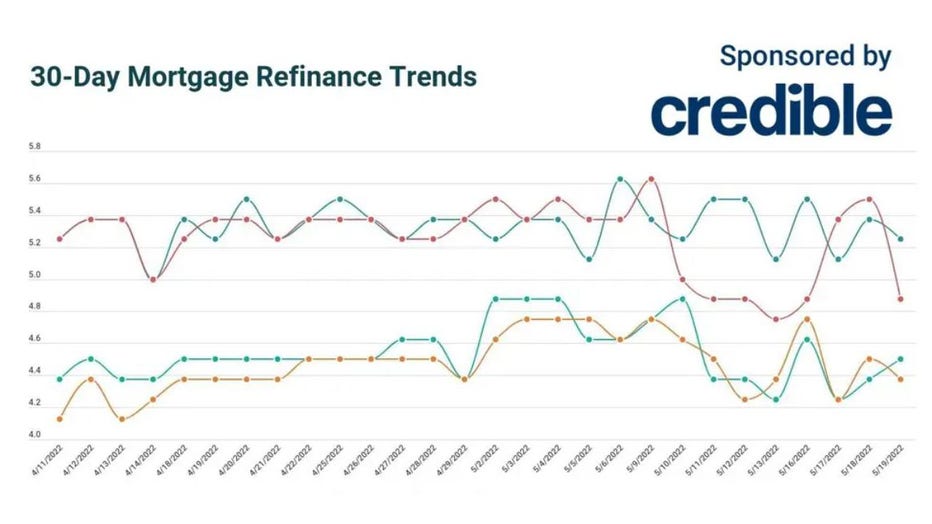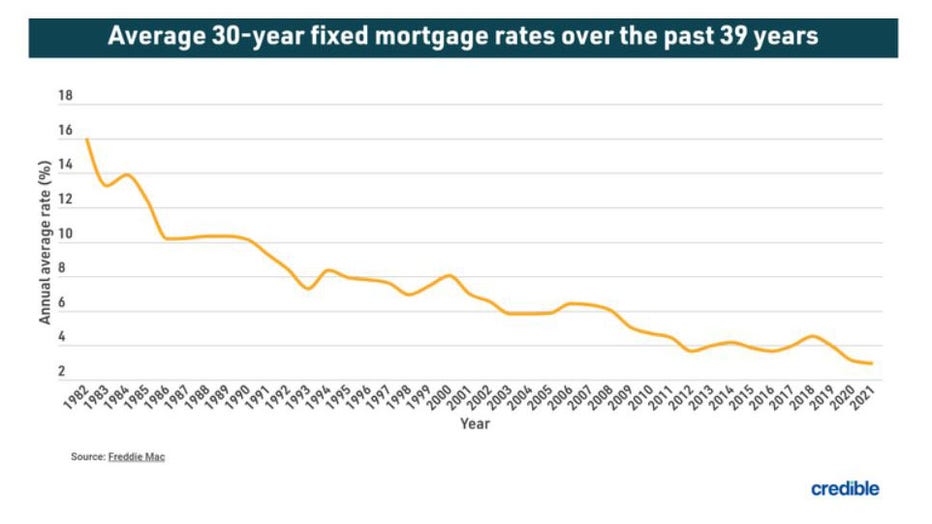Today’s best refinance deal? 20-year rates freefall under 5% | May 19, 2022
Our goal here at Credible Operations, Inc., NMLS Number 1681276, referred to as "Credible" below, is to give you the tools and confidence you need to improve your finances. Although we do promote products from our partner lenders, all opinions are our own.

Check out the mortgage refinancing rates for May 19, 2022, which are largely down from yesterday. (Credible)
Based on data compiled by Credible, mortgage refinance rates have fallen for three key terms and risen for one other term since yesterday.
- 30-year fixed-rate refinance: 5.250%, down from 5.375%, -0.125
- 20-year fixed-rate refinance: 4.875%, down from 5.500%, -0.625
- 15-year fixed-rate refinance: 4.500%, up from 4.375%, +0.125
- 10-year fixed-rate refinance: 4.375%, down from 4.500%, -0.125
Rates last updated on May 19, 2022. These rates are based on the assumptions shown here. Actual rates may vary.
If you’re thinking of doing a cash-out refinance or refinancing your home mortgage to lower your interest rate, consider using Credible. Credible's free online tool will let you compare rates from multiple mortgage lenders. You can see prequalified rates in as little as three minutes.
What this means: Mortgage refinance rates fell across three terms today, with 20-year rates falling by more than half of a percentage point and dipping below 5%. Rates for a 30-year term are holding above 5%, so homeowners looking to refinance may find the better bargain with a 20-year term. Homeowners who want to make home improvements can save more on interest with a cash-out refinance than they would by funding those improvements with credit cards or personal loans.
WHAT IS CASH-OUT REFINANCING AND HOW DOES IT WORK?
How mortgage rates have changed over time
Today’s mortgage interest rates are well below the highest annual average rate recorded by Freddie Mac — 16.63% in 1981. A year before the COVID-19 pandemic upended economies across the world, the average interest rate for a 30-year fixed-rate mortgage for 2019 was 3.94%. The average rate for 2021 was 2.96%, the lowest annual average in 30 years.
The historic drop in interest rates means homeowners who have mortgages from 2019 and older could potentially realize significant interest savings by refinancing with one of today’s lower interest rates.

If you’re ready to take advantage of current mortgage refinance rates that are below average historical lows, you can use Credible to check rates from multiple lenders.
How to get your lowest mortgage refinance rate
If you’re interested in refinancing your mortgage, improving your credit score and paying down any other debt could secure you a lower rate. It’s also a good idea to compare rates from different lenders if you're hoping to refinance so you can find the best rate for your situation.
Borrowers can save $1,500 on average over the life of their loan by shopping for just one additional rate quote, and an average of $3,000 by comparing five rate quotes, according to research from Freddie Mac.
Be sure to shop around and compare current mortgage rates from multiple mortgage lenders if you decide to refinance your mortgage. You can do this easily with Credible’s free online tool and see your prequalified rates in only three minutes.
How does Credible calculate refinance rates?
Changing economic conditions, central bank policy decisions, investor sentiment and other factors influence the movement of mortgage refinance rates. Credible average mortgage refinance rates reported in this article are calculated based on information provided by partner lenders who pay compensation to Credible.
The rates assume a borrower has a 740 credit score and is borrowing a conventional loan for a single-family home that will be their primary residence. The rates also assume no (or very low) discount points and a down payment of 20%.
Credible mortgage refinance rates reported here will only give you an idea of current average rates. The rate you receive can vary based on a number of factors.
Think it might be the right time to refinance? Be sure to shop around and compare rates with multiple mortgage lenders. You can do this easily with Credible and see your prequalified rates in only three minutes.
Are refinance rates higher than purchase rates?
Refinance rates are generally higher than rates for new mortgages to buy a house. Here are some factors that influence the higher rates:
- Risk — A borrower who refinances into a shorter term to get a lower interest rate and pay off their loan sooner may end up with a higher monthly payment. That higher payment could translate into an elevated risk of default. Likewise, in cash-out refinances, the borrower’s debt-to-income ratio rises — and possibly their risk of defaulting.
- Revenue — A lender may be able to make more money off a purchase loan than a refinance. Many homebuyers choose longer terms for purchase mortgages, which come with higher interest rates. Refinancing into a shorter term and/or lower interest rate reduces the amount of interest the lender makes over the life of a loan.
- Costs — Refinancing a mortgage comes with many of the same closing costs you’ll face when you take out a new mortgage, such as an appraisal, attorney fees and more. Closing on a refinance also has costs for the lender. But whereas the lower interest rate and shorter term you get with a refinance benefits you financially, the lender will make less in interest over the life of the refinanced loan.
- Your credit — Hopefully, your credit continues to improve once you become a homeowner. But that’s not always the case for everyone. A homeowner whose credit score has actually fallen since they initially bought the house may look like a bigger risk to lenders — who may charge a higher interest rate to offset the perceived risk.
Have a finance-related question, but don't know who to ask? Email The Credible Money Expert at moneyexpert@credible.com and your question might be answered by Credible in our Money Expert column.
As a Credible authority on mortgages and personal finance, Chris Jennings has covered topics that include mortgage loans, mortgage refinancing, and more. He’s been an editor and editorial assistant in the online personal finance space for four years. His work has been featured by MSN, AOL, Yahoo Finance, and more.

